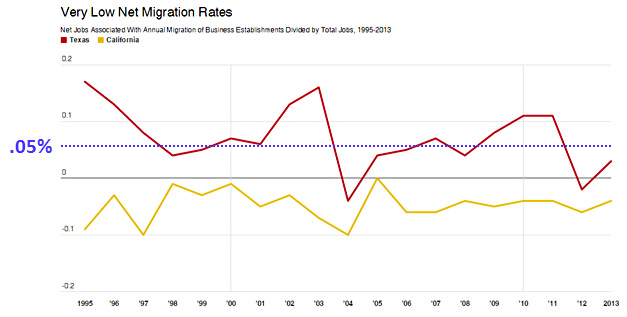Is California losing jobs to Texas, thanks to California’s stringent anti-business regulations vs. Texas’s wide-open business-friendly environment? It’s a question I have only a modest interest in, since there are lots of reasons for states to gain or lose business. California has nice weather. Texas has cheap housing. Recessions hit different states at different times and with different intensities. Business regulations might be part of the mix, but it’s all but impossible to say how much.
But now I care even less. Lyman Stone ran some numbers and confirmed that, in fact, California has been losing jobs and Texas has been gaining jobs over the past couple of decades. But by itself that isn’t very interesting. The real question is, how many jobs? Here is Stone’s chart:

Stone comments: “Net migration isn’t 1% or 2%. It’s plus or minus 0.05% in most cases. Even as a share of total change in employment, migration is massively overwhelmed by employment changes due to local startups and closures, and local expansions and contractions. The truth is, net employment changes due to firm migration are within the rounding error of total employment. Over time they may matter, but overall they’re pretty miniscule.”
What’s more, these numbers are for migration to and from every state in the union. They’re far smaller if you look solely at California-Texas migration.
Bottom line: An almost invisible number of workers are migrating from California to Texas each year due to firm relocation, probably less than .02 percent. The share of that due to burdensome business regulation is even less, probably no more than .01 percent. That’s so small it belongs in the “Other” category of any employment analysis. No matter how you look at it, this is just not a big deal.
UPDATE: In a Twitter conversation, Stone makes it clear that this is solely a look at job migration tied to firm relocation. The idea is to test the theory that Texas is “poaching” companies from California thanks to its anti-business climate, and it seems pretty clear that this just isn’t happening in numbers large enough to be noticeable.
There are lots of other things to say about this, including the number of new startup firms in each state, where existing firms choose to expand, and so forth. Those would be interesting things to look at, but for another day. This is strictly a look at the supposed poaching phenomenon.













